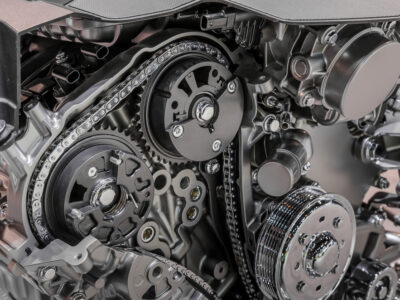
Replacing Worn Suspension Components on a Fiat 500

The Fiat 500 is a stylish and fun-to-drive city car that has gained a loyal following worldwide. However, like any vehicle, it requires regular maintenance to keep it running smoothly. One crucial aspect of this maintenance is replacing worn suspension components, which can significantly impact the car's handling and overall performance. Over time, the suspension parts can wear out, causing a decrease in ride comfort and stability. Replacing these components is essential to maintain the car's original ride quality and ensure a safe driving experience, this article will guide you through the process.
Replacing Worn Suspension Components: A Guide for Fiat 500 Owners
Replacing worn suspension components on a Fiat 500 is a crucial maintenance task that ensures the vehicle's optimal performance, safety, and comfort. The suspension system plays a vital role in absorbing bumps, maintaining tire contact with the road, and providing stability while driving. Over time, suspension components can wear out, leading to a decrease in the vehicle's overall handling and potentially causing uneven tire wear. Regular inspections and timely replacements are essential to prevent further damage and maintain the vehicle's overall health.
Identifying Worn Suspension Components
To replace worn suspension components, it's essential to identify the parts that need replacement. Common signs of worn suspension components on a Fiat 500 include uneven tire wear, vibrations while driving, and clunking or knocking noises when navigating bumps. Inspecting the suspension system regularly can help detect worn components early on. Look for signs of excessive wear, rust, or damage on components such as control arms, ball joints, and shock absorbers.
Replacement Procedures and Tools
Replacing worn suspension components on a Fiat 500 requires specialized tools and a thorough understanding of the suspension system. The replacement process typically involves removing the wheel, disconnecting the brake caliper, and loosening the suspension component from its mounting points. Specialized tools, such as a ball joint separator and a control arm bushing tool, may be required to complete the replacement. It's also essential to consult a repair manual or seek professional assistance if you're unsure about the replacement procedure.
Recommended Replacement Parts and Costs
When replacing worn suspension components on a Fiat 500, it's crucial to use high-quality replacement parts that meet the manufacturer's specifications. The cost of replacement parts can vary depending on the component and the supplier. Here's a rough estimate of the costs associated with replacing common suspension components:
| Component | Cost |
|---|---|
| Control Arm | $150-$300 |
| Ball Joint | $50-$100 |
| Shock Absorber | $200-$400 |
Using OEM-quality parts can ensure that the replacement components meet the manufacturer's standards and provide optimal performance and durability.
What is the suspension problem with the Fiat 500?
The Fiat 500 is a popular city car known for its stylish design and compact size. However, some owners have reported issues with the suspension system. The suspension problem with the Fiat 500 is related to its design and functionality.
Suspension Issues on Rough Roads
The Fiat 500's suspension is designed to provide a comfortable ride on smooth roads, but it can be prone to issues when driven on rough or uneven surfaces. When driving on such roads, the suspension can become noisy, and the ride can become uncomfortable. Some of the common issues that occur when driving on rough roads include:
- The suspension can become noisy due to worn-out components or inadequate damping.
- The car's ride height can be affected, leading to a decrease in overall ride comfort.
- The suspension can be damaged due to excessive stress, leading to costly repairs.
Common Symptoms of Suspension Problems
The symptoms of suspension problems in the Fiat 500 can vary, but some common signs include a noisy or bumpy ride, uneven tire wear, and a decrease in handling performance. When the suspension is not functioning properly, it can cause a range of issues, including:
You may be interested in reading How to Replace a Faulty Power Steering Motor in a Fiat 500
How to Replace a Faulty Power Steering Motor in a Fiat 500- A noisy or clunking sound when driving over bumps or uneven surfaces.
- Uneven tire wear due to improper wheel alignment or worn-out suspension components.
- A decrease in handling performance, making the car more difficult to control.
Causes and Consequences of Suspension Failure
The causes of suspension failure in the Fiat 500 can be attributed to a range of factors, including worn-out components, inadequate maintenance, and driving conditions. When the suspension fails, it can have significant consequences, including a decrease in ride comfort, handling performance, and overall safety. Some of the common causes and consequences include:
- Worn-out components, such as shock absorbers or struts, can lead to a decrease in ride comfort and handling performance.
- Inadequate maintenance, such as failing to replace worn-out components, can lead to more severe issues and costly repairs.
- Driving conditions, such as driving on rough or uneven roads, can cause excessive stress on the suspension, leading to premature wear and failure.
How much does it cost to replace struts on a Fiat 500?
The cost to replace struts on a Fiat 500 can vary depending on several factors such as the model year, type of struts, and labor costs. On average, the cost can range from $400 to $800 for a pair of struts, including parts and labor.
Factors Affecting the Cost of Strut Replacement
The cost of replacing struts on a Fiat 500 is influenced by several factors, including the type of struts, labor costs, and whether any additional repairs are needed. The cost can be broken down into the cost of the parts and the labor cost.
- The type and quality of the struts, with OEM parts generally being more expensive than aftermarket parts.
- Labor costs, which can vary depending on the mechanic's rate and the time required to complete the job.
- Any additional repairs that may be needed, such as replacing other suspension components.
Average Cost of Strut Replacement for Different Fiat 500 Models
The cost of strut replacement can vary depending on the model year and type of Fiat 500. For example, the cost for a 2012 Fiat 500 may be different from that of a 2017 Fiat 500 Abarth.
- The cost for a standard Fiat 500 model may be lower compared to a high-performance model like the Abarth.
- Later models may have more complex suspension systems, increasing the cost of replacement.
- Some models may have specific requirements or recommendations for strut replacement, affecting the overall cost.
Additional Costs to Consider When Replacing Struts on a Fiat 500
When replacing struts on a Fiat 500, there are other costs to consider beyond the initial cost of the parts and labor.
- Additional suspension or steering components may need to be replaced at the same time.
- Wheel alignment may be necessary after strut replacement, adding to the overall cost.
- Any other repairs or maintenance recommended during the strut replacement process.
What is the most common fault with the Fiat 500?

The most common fault with the Fiat 500 is related to its electrical and mechanical systems. Various model years have been plagued by issues such as faulty electronics, transmission problems, and engine faults.
Electrical System Faults
The electrical system of the Fiat 500 is prone to faults, which can cause a range of problems, including faulty dashboard lights, non-functional infotainment systems, and issues with the car's starting system. Some of the common electrical faults are due to the complex electronics and wiring in the vehicle.
- Faulty wiring and connections
- Malfunctioning control modules
- Software glitches and bugs
Transmission and Engine Issues
Transmission and engine issues are also common faults found in the Fiat 500. Problems with the transmission can cause the car to hesitate or fail to shift gears properly, while engine issues can lead to reduced performance and fuel efficiency.
You may be interested in reading How to Replace a Faulty Power Steering Motor in a Fiat 500
How to Replace a Faulty Power Steering Motor in a Fiat 500 Fixing Loose Trim and Interior Rattles in Your Fiat 500
Fixing Loose Trim and Interior Rattles in Your Fiat 500- Slipping or faulty transmission
- Engine oil leaks and consumption
- Faulty fuel injectors and pumps
Rust and Corrosion Problems
Some Fiat 500 models have been known to suffer from rust and corrosion, particularly in certain regions with high humidity and salted roads. Rust can weaken the car's body and lead to costly repairs if left unchecked.
- Rust spots on body panels
- Corrosion on suspension and steering components
- Water ingress and moisture accumulation
What are the bad years of the Fiat 500?

The Fiat 500 is a popular city car that has been in production since 2007. While it has received praise for its stylish design and fuel efficiency, some model years have been plagued by issues. The bad years of the Fiat 500 are generally considered to be the early models, particularly those produced between 2007 and 2012.
Reliability Concerns
The early Fiat 500 models were criticized for their reliability issues. Some owners reported problems with the car's electrical system, transmission, and engine. These issues were often caused by software glitches and faulty sensors.
- The electrical system was prone to faults, causing issues with the car's infotainment system and other accessories.
- The transmission was also known to be problematic, with some owners reporting slipping or hesitation between gears.
- Engine issues were also common, with some owners reporting oil leaks and other problems.
Safety Issues
Some model years of the Fiat 500 have been recalled due to safety concerns. For example, certain models were recalled due to issues with the car's airbag system and seatbelts. These issues were often caused by faulty sensors and software glitches.
- The airbag system was prone to faults, which could prevent the airbags from deploying in the event of a crash.
- The seatbelts were also known to be problematic, with some owners reporting issues with the seatbelt retractors.
- Some models were also recalled due to issues with the car's brakes, which could increase the risk of an accident.
Common Problems
In addition to reliability and safety concerns, some Fiat 500 models have been plagued by other common problems. These include issues with the car's cooling system, fuel system, and suspension.
- The cooling system was prone to leaks, which could cause the engine to overheat.
- The fuel system was also known to be problematic, with some owners reporting issues with the fuel pump and fuel injectors.
- Suspension issues were also common, with some owners reporting a rough ride and uneven tire wear.
Frequently Asked Questions
What are the signs that indicate worn suspension components on a Fiat 500?
Signs of worn suspension components on a Fiat 500 include uneven tire wear, vibrations while driving, and a bouncy or unstable ride. You may also notice clunking or rattling noises when driving over bumps. If you experience any of these symptoms, inspect your suspension components for wear and consider replacing them to maintain your vehicle's performance and safety.
How do I inspect the suspension components on my Fiat 500?
To inspect the suspension components, start by visually checking for signs of wear or damage. Look for rust, dents, or excessive play in the components. Check the shock absorbers and struts for leaks or damage. You can also perform a bounce test to check the condition of the suspension. If you're unsure, consult a repair manual or seek the help of a professional mechanic.
Can I replace worn suspension components on my Fiat 500 myself?
Replacing worn suspension components on a Fiat 500 can be a challenging task, requiring specialized tools and knowledge. While it's possible to do it yourself, it's recommended to seek the help of a professional mechanic if you're not experienced with suspension repairs. They can ensure the job is done correctly and safely, and provide a warranty on their work.
What are the benefits of replacing worn suspension components on my Fiat 500?
Replacing worn suspension components on your Fiat 500 can improve the vehicle's handling, stability, and overall performance. It can also enhance safety by reducing the risk of accidents caused by worn or faulty suspension. Additionally, new suspension components can improve ride comfort and reduce wear on other vehicle components, such as tires and steering components.
You may be interested in reading How to Replace a Faulty Power Steering Motor in a Fiat 500
How to Replace a Faulty Power Steering Motor in a Fiat 500 Fixing Loose Trim and Interior Rattles in Your Fiat 500
Fixing Loose Trim and Interior Rattles in Your Fiat 500 How to Replace a Broken Door Handle on a Fiat 500
How to Replace a Broken Door Handle on a Fiat 500
If you want to know other articles similar to Replacing Worn Suspension Components on a Fiat 500 you can visit the category Maintenance.
Deja una respuesta







More content of your interest